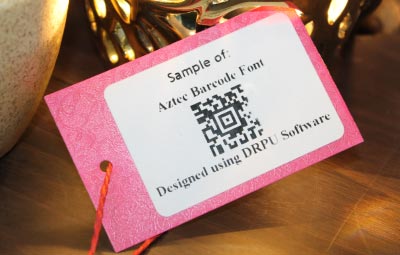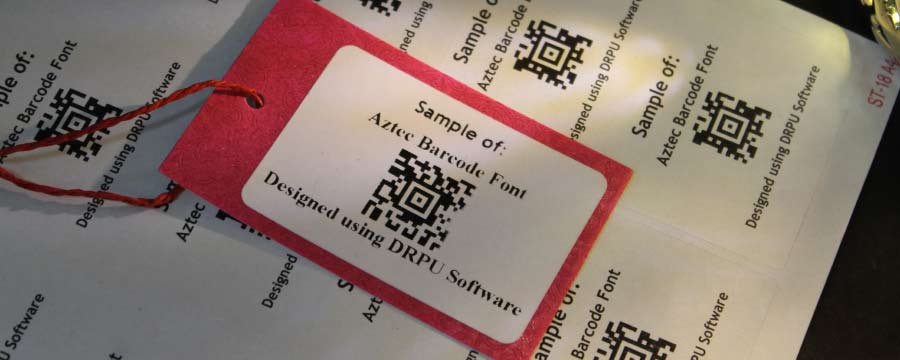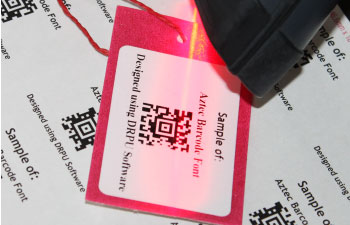Aztec Barcode System
Last Updated On:
Aztec Barcode System
The Aztec barcode is often used in applications where space is limited, such as on medical devices or in logistics operations. It is also used in applications where a large amount of data needs to be stored, such as on event tickets or airline boarding passes. Additionally, the Aztec barcode is used in mobile marketing campaigns, where it can be scanned by a smartphone to access coupons or other promotions.

The structure of an Aztec barcode is designed to provide a compact and robust means of encoding data in a two-dimensional matrix format. The use of error correction codes and control characters helps to ensure that the data can be accurately decoded even in challenging conditions.
The Aztec barcode is a two-dimensional matrix barcode that is capable of storing large amounts of data in a small space. It is highly versatile, can be read from any direction, and has built-in error correction. It is used in a wide range of applications, including transportation, retail, and healthcare, and is considered to be more secure than traditional barcodes.
📝In addition to its high data density, Aztec barcode also has a small form factor. It can be printed on a small label or even directly onto a product, making it ideal for applications where space is limited. This is particularly useful in the transportation industry, where products and packages need to be labeled with barcodes that can be read quickly and easily.
One of the main advantages of Aztec barcode is its ability to encode both alphanumeric and binary data. This allows it to be used for a variety of applications, including tracking and tracing packages, inventory management, and identification of medical samples. It also supports advanced error correction, making it more resistant to damage and distortion.
Another advantage of Aztec barcode is its high data density. It can encode up to 3,000 characters of data in a single barcode, which is significantly more than other barcode types such as QR codes or Data Matrix codes. This makes it ideal for applications where a large amount of information needs to be stored in a small space.
Aztec barcode is a 2D matrix barcode that is capable of encoding large amounts of data in a small space. Its design allows it to be used in a wide range of applications, including transportation,inventory management. It can be encrypted to prevent unauthorized access to the encoded data, where sensitive information is being transmitted.
Aztec barcode is also unique in its ability to encode data in a circular pattern. This makes it more versatile than other 2D barcodes, which are typically linear in structure. The circular design allows the barcode to be read from any angle, making it easier to scan and decode. Barcode make it a reliable solution for a wide range of applications.
Information Encoded in Aztec Barcode System

❖ Aztec barcode is a two-dimensional matrix barcode that can store large amounts of data in a small space. The type of information that can be encoded in an Aztec barcode depends on the size of the barcode and the number of data modules it contains. In general, an Aztec barcode can encode any type of data, including text, numbers, and binary data. The maximum amount of data that can be encoded in an Aztec barcode is approximately 3832 alphanumeric characters or 3067 bytes of binary data.
❖ The structure of an Aztec barcode is divided into two parts: the data region and the control region. The data region contains the actual data that is being encoded in the barcode. The control region contains information about the data, such as the size of the barcode, the error correction level, and the encoding mode.
❖ The encoding mode of an Aztec barcode determines the type of data that can be encoded. There are four encoding modes: binary, numeric, alphabetic, and byte. The binary mode can be used to encode any type of binary data, including images, audio files, and other multimedia content. The numeric mode is used to encode numbers, while the alphabetic mode is used to encode text. The byte mode is used to encode any type of binary data that cannot be represented in the binary mode.
❖ In addition to the data that is being encoded, an Aztec barcode can also contain additional information, such as a version number, error correction level, and a mask pattern. The version number specifies the size of the barcode, while the error correction level determines the amount of redundancy that is added to the barcode to ensure that it can be read even if some of the data modules are damaged or missing. The mask pattern is used to ensure that the barcode can be read under different lighting conditions.
📝 Overall, an Aztec barcode is a versatile barcode that can encode a wide range of data types, making it useful for a variety of applications.
Applications Of Aztec Barcode System
Aztec barcode is a two-dimensional (2D) matrix barcode that can encode large amounts of data in a small space. It has several applications across various industries due to its compact size and high data density. Some of the applications of Aztec barcode are discussed below:
Aztec barcode is commonly used in the transportation and logistics industry for tracking and managing packages, containers, and inventory. The barcode can store a large amount of information, such as shipment details, weight, destination, and origin, which can be easily scanned and updated throughout the supply chain.
Aztec barcode is commonly used for ticketing and access control at events, such as concerts, sports games, and exhibitions. The barcode can store ticket information, including seat number, date, and venue, which can be easily scanned at the entry point.Aztec barcode are diverse and wide-ranging, making it a popular choice for businesses and industries that require high-capacity data storage in a compact format.
Aztec barcode is used in retail and inventory management to track and manage products, pricing, and inventory levels. The barcode can store a wide range of information, such as product code, price, description, and inventory levels, which can be easily updated and tracked throughout the supply chain. Features make it an ideal choice for applications where space is limited and data security is a concern.
Aztec barcode is widely used in the healthcare industry to manage patient information, medication, and medical equipment. The barcode can store important patient data, such as name, age, medical history, and prescribed medication, which can be accessed quickly and accurately by healthcare providers. Its high data density, small form factor, and security.
Aztec barcode is used for mobile payments and mobile marketing campaigns. The barcode can store payment information, such as account number and transaction details, and can be scanned using a mobile device to complete a payment transaction. Additionally, Aztec barcode can be used in mobile marketing campaigns to provide customers with exclusive discounts, promotions, and loyalty rewards.
Aztec barcode is used by government agencies and public services to store and manage important data, such as identity documents, passports, and visas. The barcode can store biometric data, such as fingerprints and facial recognition, which can be easily accessed and verified by authorized personnel.
Aztec barcode is used in the manufacturing and production industry to track and manage inventory levels, production processes, and quality control. The barcode can store information related to the manufacturing process, such as product details, production date, and quality control measures, which can be easily accessed and tracked throughout the supply chain.
The barcode must be scanned books at a relatively close range for accurate data retrieval, typically within a few inches. This can be a challenge for applications that require scanning from a distance, such as in books barcode. The widespread use of Aztec barcodes in a variety of applications has led to the availability of a wide range of devices and software that can read and decode them, making them a versatile and widely used barcode type.
Aztec Barcode Read and Decode

Aztec barcode is a two-dimensional matrix barcode that uses a square grid of black and white cells to encode information. The barcode can be read by imaging devices such as smartphones, scanners, and cameras. In this section, we will discuss how Aztec barcode is read and decoded.
There are different techniques for reading Aztec barcode, but the most common method is using an imaging device such as a camera or scanner. The imaging device captures the image of the barcode, and the software analyzes the image to extract the information encoded in the barcode.
1. The decoding process starts with image preprocessing, which involves cleaning and enhancing the image to improve the readability of the barcode. This step may involve techniques such as noise reduction, contrast adjustment, and edge detection. The goal of preprocessing is to remove any distortions in the image that could interfere with the decoding process.
2. Once the image has been preprocessed, the software searches for the finder pattern, which is a unique sequence of black and white cells that marks the start and end of the barcode. The finder pattern helps the software to locate the barcode within the image and determine its orientation.
3. After locating the barcode, the software divides it into individual cells and assigns a binary value (0 or 1) to each cell depending on its color (black or white). The binary values are then decoded using Reed-Solomon error correction algorithm, which can correct errors caused by noise or other factors.
4. The Reed-Solomon algorithm uses a mathematical formula to correct errors and reconstruct the original message encoded in the barcode. The decoded message is then verified using a checksum, which is a mathematical function that detects any errors that may have occurred during the decoding process.
5. Finally, the decoded message is sent to the application that requested it, such as a point-of-sale system or inventory management software. The application uses the information to perform various tasks such as tracking inventory, processing orders, and managing customer data
📝 In summary, Aztec barcode is read and decoded using imaging devices such as cameras and scanners, and the decoding process involves preprocessing the image, locating the barcode, dividing it into individual cells, assigning binary values to the cells, correcting errors using Reed-Solomon algorithm, and verifying the decoded message using a checksum.